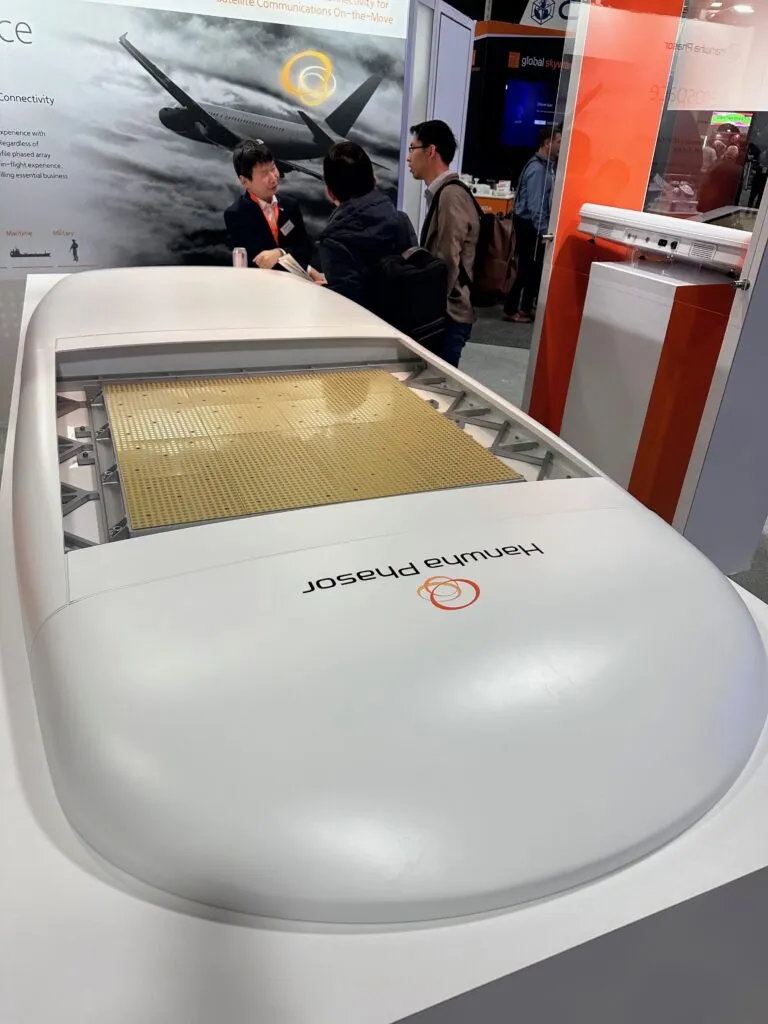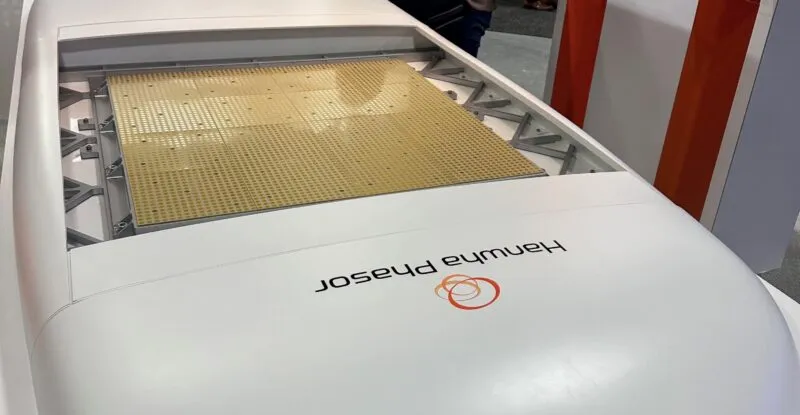First-generation electronically steered antennas (ESAs) have arrived in civil aviation but next-gen kit that can simultaneously connect to satellites in geostationary orbit (GEO) and low or medium earth orbit are already under development by key industry players including Hanwha Phasor.
A division of Korean aerospace and defense company Hanwha, London-headquartered Hanwha Phasor aims to bring a multi-beam, multi-orbit and “constellation agnostic” aero ESA to market in 2025, initially in the Ku-band, company executives told Runway Girl Network at the Satellite 2024 conference and exhibition in Washington, D.C.
Dubbed the Phasor A7700, this ESA “is effectively two beams on receive, one beam on transmit,” explained Hanwha Phasor chief operating officer Dominic Philpott.
“[T]he two beams is kind of important in terms of flexibility for the customer because it means that they can either have each of those beams on a different constellation — so, you can have one beam on LEO and the other beam on, say, an Intelsat GEO satellite, so, you can use it for different applications — or you can have it, both beams on the same constellation if you want. We do support ‘make before break’ if the user wants to do it like that or we can do fast switching of the beams.”
In terms of differentiating its hardware from other multi-beam ESAs slated to enter the market, Hanwha Phasor is “fairly unique” in having two receive beams, he said. “And the other thing is we are truly constellation agnostic. So, we will work with GEO constellations and we will work with LEO constellations.” It already has a terminal development agreement with Eutelsat OneWeb for OneWeb LEO.
Additionally, one of Hanwha Phasor’s partners is presently building a waveform, “basically a modem, a box that does multiple waveforms”, revealed company vice president business development Michael Young. “So, we would integrate that into our antenna, so then you have a multi-beam, multi-orbit, multi-waveform solution, so then a lot of the aircraft manufacturers and aircraft IFC providers are not tied to a specific vendor. They can literally pick and choose whoever they want to use at that given time.”
Such a configuration would also address a pain point for airlines: the current need to swap antennas to support new satellite services. “[O]bviously for the airline one of the major costs is the installation of the antenna. Once our antenna is on board the airplane, you just leave it and you can just choose who you want, whether it’s because you got restricted connectivity in a particular region or for commercial reasons because you just get a better deal from a different satellite provider. So, we give the airlines that flexibility,” said Philpott.
In the retrofit world, Hanwha Phasor hopes to begin the A7700 supplemental type certification process soon. Indeed, it is planning flight tests for this year. STC work for the tile-based kit will initially focus on the Airbus A320 or the Boeing 737.
“Our early discussions have proven that the price that we’re offering is liked by the airlines,” Philpott confided to RGN. “So, I would say we are kind of in the right ballpark and you know … everybody we talk to in the industry is very excited and we are excited as well. We continue to grow, we continue to recruit staff and people. And personally, I think we have got a great future over the next couple years.”
Getting to this point “has been a big paradigm shift for us”, noted Young.
“Phasor Solutions previously was kind of an R&D company, looking at technology. And now where we are after the investment of Hanwha and acquisition of Hanwha is we have been able to take that R&D and that research and actually productize it,” he explained.
“And so, our L3300 product [the land antenna for first responders and armed forces personnel] will be launched this year. We actually have deliveries to certain customers at the end of this year and it’s the same development timeline that we are doing with our aviation platform, it just has got to go through the DO-160 and the STC process. But everybody’s waiting to see that because once we have proven it and it works, I believe the flood gates are going to open at that point.”
The firm is 100% committed to delivering its aero ESA to airlines and OEMs with a radome developed by Lufthansa Technik (LHT). And indeed, Hanwha Phasor is keen to broaden its partnership with LHT.
“[I]n terms of the Lufthansa Technik relationship they’re obviously supplying the radome today but we are also looking at working with them for different other aspects of the partnership beyond that,” revealed Philpott: “And one of the main drivers of working with Lufthansa for us is that they are a credible tier one provider within the industry and they bring knowledge to us within that industry. So, our expertise is within satcom; what Lufthansa brings is aero know-how and together that makes us a stronger partnership.”
The radome, explained Young, “provides a longer life to the antenna. It protects all the components and makes it much more weather resistant and it just helps.” It also addresses drag issues and helps ensure that any slush forming atop the structure slides down. Slush atop an ESA degrades the service.
“So that’s kind of why we partnered with Lufthansa,” he continued. “So, what they’ve done is they’ve designed a new radome specifically for our antenna that takes those factors into account. So, if you look at it, it’s kind of a shaped radome, so anything would basically fall off of it and then also if you look at our antenna, we have a much lower profile than a lot of our competitors.
“So, even with the installation of a radome on top of our aircraft we are still at a total lower height and so again we are not worried about the drag. And so, we have already done some calculations and the drag coefficients is negligible, I mean I am not going to say it’s not there, because physics are physics, but it’s much less than you are seeing with some of the other systems on the market.”

The terminal is following the ARINC 792 standard footprint for commercial aviation. Image: Mary Kirby
Importantly, together with the fairing, the radome will also be used for heat dissipation of the large-footprint active ESA, which is passively cooled.
“[T]he fairing is there for aerodynamics but we also drag heat out of the two receive and transmit antennas and we dump them at either end of the radome and then the airflow over the top of the radome basically cools those two sides. So, that’s how we are getting the heat out of the system,” explained Philpott.
Hanwha Phasor can scale the size of the apertures for different applications and different platforms. It is, for instance, looking at a smaller A5500-branded antenna as an option for certain single-aisle jets. And it can even go smaller for business jets.
Interestingly, in the context of smaller business jet applications for Hanwha Phasor’s scalable tile-based technology, the company is “talking to some aircraft manufacturers about putting our system onto aircraft where it would basically almost be underneath the skin or in another location where you would not be able to see it”, revealed Young.
Among the benefits of working with Hanwha Phasor is that the firm can make its own chipsets. “[O]ne of the biggest power consumers within the antenna is the beamform chipset and so again that’s one of the key drivers of our ASIC development team is to reduce the power consumption of those beamformers so that the overall power consumption is reduced on the antenna,” said Philpott.
“But it also allows us to do things on-chip that normally you would do on a discreet printed circuit board. So, some of the other aspects of other projects we are working on at the moment will allow us to remove printed circuits at least from the design, put that onto a chip and that will reduce weight, again reduce power consumption but also improve reliability. And without that you are not in control of your own destiny, you are only available to use the technology that’s out there and really to some degrees that removes the flexibility for you to optimize the design, or a trade in performance, power, weight and all those things. So that’s the key for us.”
The company is taking a two-phased approach to addressing aero. “We see the retrofit market, going after systems that already have one, either legacy/end of life, or they may not be performing and then we also see the linefit market as a new entry point because ultimately all the aircraft manufacturers would love to install an antenna onto the aircraft because it reduces costs totally,” said Young.
“However, all aircraft manufacturers are waiting because there is not a single antenna that they can put on there. If they put antenna X on there, it is only limited to this network provider, this service provider, this satellite. Same thing with antenna B, it’s the same thing. So, if they can find an antenna that supports, you know, 80-90 percent of the market I think they will linefit those because then they can get economies of scale.”
A Ka-band multi-beam antennas is expected to be developed in time. “[W]e will push the Ku product out to market and then we can do a lot of technology reuse from what we did on Ku to develop our Ka-band. So by the time the Ka-band networks are out there, the Rivadas, the Telesats, we can have a solution in the same timeframe.”
Related Articles:
- Airbus successfully flight tests Get SAT antenna for HBCplus
- Kymeta eyes strategic partner in aero
- Eutelsat OneWeb to support inflight connectivity from September 2024
- Telesat on why the wait for Lightspeed will be worth it in aero
- OneWeb-powered Galileo to be competitively priced to Starlink: Gogo
- Stellar Blu to develop multi-orbit, multi-beam aero ESA with BAE tiles
- Intelsat makes the case for multi-orbit IFC versus LEO-only
- A new drag race: ThinKom invites Stellar Blu to antenna challenge
- Rivada looks to change the game in inflight connectivity











